Crate training is one of those things that should begin as soon as you bring your new little puppy pal home. It is a heck of a lot easier to introduce a puppy to a crate than trying to force an adult dog to get used to one!
This training process is not necessarily easy in the midst of it, but you will reap the benefits from it for the rest of your dog’s life, and you will be able to give yourself (and your pup) a pat on the back and say…. “I am so glad we did that!”
In this post we are going to talk about some the best crates for training a puppy, why we recommend them, and different methods that you can use to approach crate training.
What to look for.
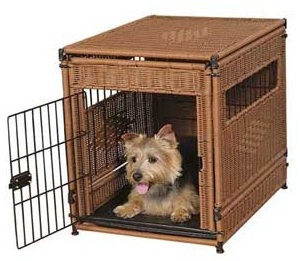
There are so many dog crates on the market today that it can be a little overwhelming trying to pick one out for your new puppy.
Crates come in all different sizes and can be made from soft materials, hard plastic, metal, and some are a mix of metal, wood, and/or wicker for a more “sophisticated” look. 😉
Below is a list of things you should look for when you’re picking out your pup’s first crate for training.
1. CORRECT SIZE
– The crate should allow enough room for the dog to stand, lie down, stretch out, and turn around comfortably. Your dog should not have room to walk around or play inside of his crate. Dog’s naturally do not like to use the bathroom in the same place that they are sleeping, so if you keep the crate small enough they will not want to have an accident in it.
2. DURABILITY
– Metal Wire crates or plastic crates are best for training. The soft material crates should be avoided until they are older and 100% crate trained, and the fancy crates that look like end tables and what not, are very heavy, and most times do not fold up, making it difficult, if not impossible, to bring along with you to other places if need be.
– The crate needs to be a sturdy, and safe place for your dog to rest. You don’t want to get something low quality that your new little friend will be able to escape from.
3. FLEXIBILITY
– I touched on this a bit in the last section, but it would be extremely helpful to get a crate that folds up for easy traveling or storage purposes! However, this mostly applies to medium – large sized dogs, as small dog crates that do not fold down, are not as much of a space issue!
– There are also crates that have dividers so that it can grow with your dog, allowing you to only have to purchase one crate, instead of several as they get bigger.
4. VENTILATION
– You definitely want the crate you pick to have adequate ventilation for your dog, so they can get plenty of fresh air!
So which one to choose!?

Well, the crate you choose will partly depend on your lifestyle and your availability to be with the dog. It is not okay to leave a new puppy in a crate for an entire 8+ hour day while you work. They cannot hold their bladders that long yet, and it sets them up for failure. Dog’s love to please their people. So make sure you set them up for success as much as you possibly can.
If you need to leave your puppy at home while you’re at work, you should either have someone stop in to check on him, and let him outside a few times while you’re gone, or you should have a playpen attached to his crate and some kind of indoor potty system, which I will talk about a bit more later on!
Ideally, it is best to not bring a new puppy into your home if you cannot spend a good deal of time around them, and working with them.
That being said, let’s get into our top 3 picks below, and talk about why we love them!
AmazonBasics Double Door Folding Metal Dog Crate

![]() This crate is perfect for your basic crate training needs. It has two doors for ease of use, it collapses down, and it has a divider in it so the crate can grow with your dog! When your dog is still small you can put the divider in a place that only allows your puppy an ample amount of room to sleep and turnaround comfortably, and as she grows, you can move the divider, until she is eventually allowed the whole crate!
This crate is perfect for your basic crate training needs. It has two doors for ease of use, it collapses down, and it has a divider in it so the crate can grow with your dog! When your dog is still small you can put the divider in a place that only allows your puppy an ample amount of room to sleep and turnaround comfortably, and as she grows, you can move the divider, until she is eventually allowed the whole crate!
I love this option because it is much more affordable than buying several crates as your dog grows. Plus, once the dog is completely house-trained, you may want to allow her a little more room in her crate than just enough to turn around, and you will already have that If you get a crate like this, and order one a little bigger than you think you will need for them as an adult.
Another feature that is super convenient is the plastic tray at the bottom of this style crate. If puppy does have an accident inside, it is super easy to pull out and clean up.
These crates work perfect for:
– When you are home and puppy needs a little down time, or you need a little break from keeping a constant eye on them.
– For sleeping in at night.
– When you need to leave the home.
*Note – Keep in mind, puppies should be left no more than a few hours at a time for the first few weeks. Once they have proven trust worthy with an hour or two, you can slowly (key word is slowly) increase the amount of time that you are gone. A good rule of thumb is that for every month of age, that is how many hours they can hold their bladder. Meaning if the dog is 3 months old, you can’t expect them to be able to hold their bladder for more than 3 hours at a time. This is especially true for a small dog, a larger dog may be able to do an hour or so over that general rule.
This rule works up until about 6 – 9 months of age with a small dog, and to about 8 – 12 months of age with a large dog. An adult small dog will usually not be able to go more than 9 hours without relieving themselves, and they may not even be able to make it past 5 or 6 hours. A medium to large dog can wait much longer, sometimes even up to 12 hours if totally necessary, but it is not recommended making your dog wait that long.
The Potty Training Puppy Apartment or “PTPA” by Modern Puppies
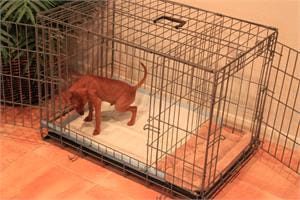 This clever design was made to be used as an indoor potty system! It is actually a genius way to teach your dog where to go potty inside, and when they are older and can hold their bladder longer, you can then transition them to go outside if you’d prefer, or continue to use the indoor potty for your pooch!
This clever design was made to be used as an indoor potty system! It is actually a genius way to teach your dog where to go potty inside, and when they are older and can hold their bladder longer, you can then transition them to go outside if you’d prefer, or continue to use the indoor potty for your pooch!
This crate has three removable doors, it is VERY sturdy, but still collapses, and has a room divider, with a little hole in it so that the dog can get to the other side of the crate. The purpose of this set-up is that the smaller side is meant to be used as their bed, and the larger side would hold a puppy pad which is meant to be used as their potty. Because dogs do not like to soil their sleeping area, they naturally go to the other side of the crate when they need to go potty. After they have gone, you simply fold up the potty pad, throw it away, and put a new one down.
The PTPA works perfect for puppy parents who:
– Do not want to get up in the middle of the night to take their new puppy outside.
– Cannot get home every 3 hours to let their puppy out.
– Want to allow their puppy a little more freedom and space while they are gone.
– Live in apartments or do not have a yard.
– Do not want to take a puppy out into bad weather.
– Do not want to take a puppy outside before they have all of their initial puppy shots.
…and the list goes on!!
READ THE FULL DESCRIPTION AND MY PERSONAL REVIEW AFTER USING THIS SYSTEM HERE!
I cannot say enough good things about the PTPA. It really helped me with the potty training process for my Yorkshire Terrier. There were three days a week that I could only get home every 5-6 hours during the day, and this system worked perfectly for her.
If you need a different option because you have to be gone from your home longer than 3 hours at a time, this could be a great solution for you!! However, I do still recommend that you take off a week or two with your new puppy, so that you can spend that time bonding and work on teaching your dog that when you leave you will come back, but this can still be a much more realistic choice for someone who wants a puppy, but just can’t be home as often as they’d like.
If you would like to check out prices for the PTPA you can check out their website HERE, and if you decide to purchase, be sure to use the code – ATY27604 at checkout for 5% off of your order! 🙂
*Note – I still would not recommend leaving a young puppy for more than 6 hours at a time if at all possible, especially little dogs, as they will need to be watched closely so that they do not develop hypoglycemia. (You can read more about Hypoglycemia in Yorkies HERE. )
AmazonBasics Two-door Top-load dog kennel

![]() This plastic crate has a really convenient top-loading door, which is especially nice when you have to get your pet out of the crate at the vet, and she isn’t wanting to budge! HA!
This plastic crate has a really convenient top-loading door, which is especially nice when you have to get your pet out of the crate at the vet, and she isn’t wanting to budge! HA!
This crate holds up really well and is a great size for a 6lb Yorkie. They also have it available in a smaller size which would be perfect for a small breed puppy.
I like plastic crates for nighttime as they just seem a little cozier and more “den-like” for a dog. They are also super handy for bringing a smaller pet on trips, or carrying them to the car and into an appointment.
These can be used for:
– Sleeping at night
– Trips
– Instead of a wire crate when you are gone for short periods of time.
– When puppy needs a rest.
– To keep puppy in a safe place while you’re working on something.
*Note – I have used a plastic kennel for my Yorkshire Terrier to sleep in at night since I first brought her home even though I used the PTPA above during the day. My reason for this is because I wanted her to be right next to me while she slept so she felt comfortable, and wasn’t lonely. I put the crate right on my nightstand and she slept great in it from the start and was even able to go 5 hours at a time without having to visit her PTPA for a potty break.
HERE IS A SIMILAR GREAT OPTION FOR LARGER DOGS
– In general for medium – large adult dogs, I prefer the wire crate over a plastic one, but they are great for all puppies, especially for those vet trips they love so much… 😉
So in conclusion…
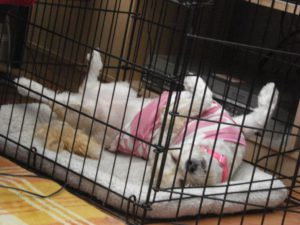
I know this post had a lot of information packed in, and you may still be a little confused about what crate is best for you and your puppy.
In my opinion wire crates are better than plastic, and I was very happy with the one listed above for other dogs Iv’e had in the past. If you want to train your dog to go potty outside from the get go, and don’t want to mess around with an indoor potty system, then the first wire crate above is a very good option for you.
BUT, If you love the idea of an indoor potty system for your dog, than PTPA is the best!! It really is a very easy way to potty train a dog. If you want to transition them to go outside eventually, that process does takes a bit of time, although very possible!! My Yorkie was completely trained with the PTPA as a puppy, and then was transitioned to go outside when we were home, and use the PTPA only when we were not home around 6 months, and now she doesn’t use her indoor potty at all anymore.
If you’d like your puppy to sleep in a more Den-like atmosphere at night, or have a small enough crate to fit on your night stand, or carry to the vet’s office, then you should definitely invest in a plastic molded crate as well. I do not recommend these for a full time use crate because they are dark, not very easy to clean, and don’t allow for as much air flow. They also do not fold down, so if you need to bring a crate on a family trip… one of these bad boys built for a Labrador retriever, may not be fitting into your car!
So let me break it down…
Wire Crates Pros:
- Durable, and can last many years
- Easy to use, and store away when not being used
- Easy to bring on trips
- Super Easy to clean out in case of accidents
- Superb ventilation
- Affordable
Cons:
- Slightly heavy, but not too bad
The PTPA Pros:
- Convenient
- Super easy to use
- Gives your puppy a little more space – (You can also attach a playpen for even more space if desired)
- Easy to bring on trips
- Easy to clean out
- Super durable
- Has great ventilation
- Perfect for apartments
Cons:
- Is a little more expensive then your typical crate
- A bit on the heavy side
- You have to stock up on potty pads to replace soiled ones
Plastic crates Pros:
- Lightweight
- Fairly durable, but doors can get flimsy after a few years
- Easy to carry with a small dog inside
- Great for sleeping in
- Great for car rides for a smaller dog
- Affordable
Cons:
- Not easy to store
- Not very easy to clean
- Dark inside
- Large ones do not travel well
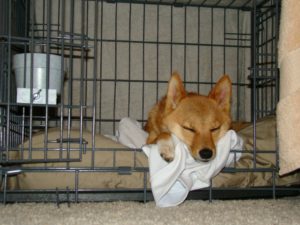 We hope this article has helped you to determine which crate would work best for your puppy, and for your lifestyle!
We hope this article has helped you to determine which crate would work best for your puppy, and for your lifestyle!
Crate training takes a lot of work, patience, and consistency, but it is SO worth it in the end to have a properly house-trained canine pal!
If you have any questions about this post, or would like to share your favorite crate for puppies, please let us know in the comments below! My pup and I love hearing from YOU!
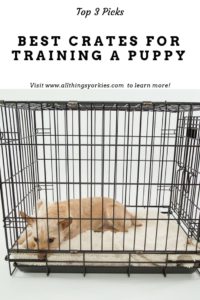
– Save this information for later, and help us spread the word by pinning this post to Pinterest!
Hover over or tap the photo to see the Pin it option.
Related Posts:
Potty Training Puppy Apartment Review – My experience using this system with my puppy!
Airline Approved Dog Carriers for In-Cabin Flights – Best dog carriers for plane rides!
Popular Posts:
Our Top Recommended Healthy Dog Treats!
Our Favorite Dog Strollers for Small Dogs.


This post is great! Very helpful. Thank you 🙂
Glad to here it! Thank you for stopping by! 🙂
This is a really informative article. I wish I had come to this site before we bought our puppy. I’d never heard of the PTPA before and this would have been the perfect solution. The amount of times I would be stood outside with an umbrella in the pouring rain, waiting for our puppy to go to the toilet.
Will be recommending this to my friends – great site.
It really is a great alternative option for beginning the potty training journey, and MUCH more convenient! Thanks for the recommendations. 🙂
Hi Sarae,
I was looking online for a crate as a gift for an elderly lady with a small dog. I ended up reading this whole article that now I will be able to have a really good conversation about as I deliver this gift to my family member.
I did not know the months of a dog is correlated to how long they can they can hold their bladder for, that is super useful 🙂 . I see the prices are very reasonable and so I am heading off there to see about delivery etc before Xmas.
Thanks again Sarae.
I am so glad this post was helpful for you!! I hope you found the perfect crate for your friend, and if you have any questions at all about crate training, feel free to shoot me an email here – allthingsyorkies@gmail.com
awesome post, love the images too.
Thank you very much
Thank You for putting together a website all about Yorkies! That is a great subject to write about. I enjoyed reading all of your posts but this one especially. I remember how trying and difficult potty training could become at times.
Thank you for the comment! Potty training and crate training can be a truly challenging time for sure, but worth every amount of effort put in! 🙂
Hi, Your work about puppy and dog care is itself an institute or a course to learn and know about every bit. I just left you a comment on dog clippers and here I am doing a comment on this amazing article. I agree with all the point your have mentioned about training a puppy. I love they way you have mentioned every bit about their care and we need to keep all these points in our mind. I have many friends and neighbors who have pet dogs so your website will be forwarded to all of then soon after i finish this comment. Well done… superb work:)
Thank you so much for your kind words! I greatly appreciate you passing along the site to your friends. 🙂
The basics of crate training a dog will require patience, the correct size crate for your dog’s build, a few toys and a lot of praise. Crate training a dog may be done for many reasons with one being safety for the animal while it is left alone. A crate should be a secure feeling place for a dog and should never be used as a punishment.
Agreed. Thank you for your feedback!